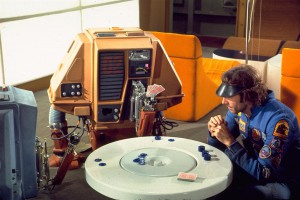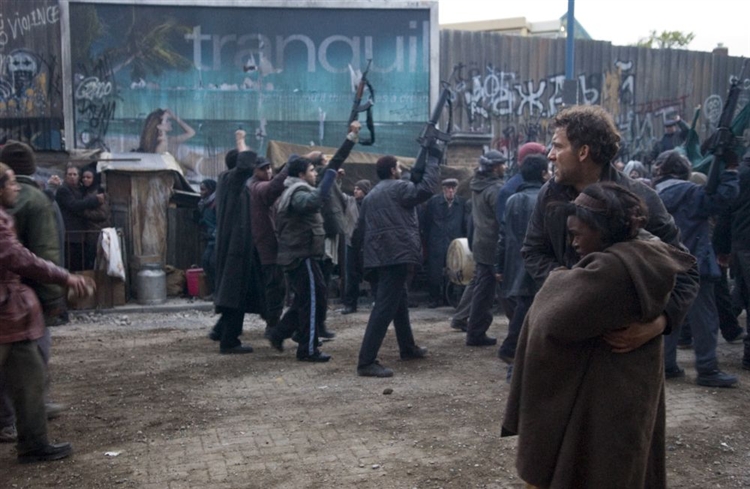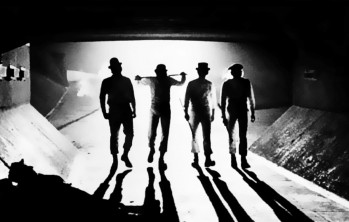Our Science Friction film season explores society’s ever-increasing dependency on technology. To find out more, AV Supervisor Dave Petty looks back at our on-screen futures and the darkness that lurks there…
2016 – according to Twitter at least – is the year the world went to pot. First it was the swathe of celebrity deaths; then the ascendance of Trump; then Brexit; then England getting knocked out of the Euros (we expected the latter; maybe not against Iceland). Just what does Lucifer have prepared next for the coming of the apocalypse? Theresa May and her newly-appointed cabinet could sprout giant hornet wings, taking flight across Europe. Hey, anything’s possible at this stage.
The idea of the dystopian apocalypse – though maybe one that doesn’t involve David Davis riding Hornet-May’s thorax into battle – is a virtually limitless well of riches within the genre confines of science fiction. And with HOME screening Douglas Trumbull’s Silent Running as part of their Science Friction season, it feels apt to rake the sands of cinema’s metaphorical desert ruins.
 Silent Running
Silent Running
With Silent Running, Trumbull – who worked as the special effects supervisor on Stanley Kubrick’s 2001: A Space Odyssey – created a paean to nature. Bruce Dern’s socially awkward astronaut Freeman Lowell tends a space-bound greenhouse carrying the last of Earth’s flora and fauna, his work treated like a joke by the ship’s spartan crew. But in three impossibly cute maintenance drones he finds kinship, one of which come the film’s conclusion may well be the custodian of the last fragile remnants of planet Earth.
It’s nothing if not heart-wrenching stuff, having developed a cult following since its 1972 release. Film critic Mark Kermode is one of its most prominent champions, citing it as one of his favourite ever works of the genre. More so, the film’s prescience in 2016 is all but cause for immediate concern. The idea that the human race have raped and pillaged the Earth to such a degree that it’s abandoned for good feels ever-more close to home; the current UK Government closing the Department for Energy and Climate Change when the world is unequivocally on the brink of creating the kind of ecological disaster Silent Running envisages.
Wall-E
The plot device of the human race abandoning Earth through reasons of their own making lays the foundations of Wall-E, arguably Pixar’s finest hour to date. The story of a solar-powered trash compacting robot – not too dissimilar in style and personality to Lowell’s mechanical trio – allows big themes to be painted on an insanely beautiful canvas, with the kind of “it’s a kid’s film but, y’know, for adults” formula that Pixar make look effortless.
Witness the opening scenes of Wall-E traversing towering skyscrapers made of perfectly cubed rubbish, his tank-like tracks cutting through dust that laces barren highways, huge megamarts (owned by the ubiquitous Buy’n’Large) that appear to go on for miles. To paraphrase Spinal Tap‘s Nigel Tufnel, it’s none more bleak. But the dystopian setting becomes mere window dressing for Wall-E’s burgeoning romance with Eve, an advanced robot sent on a mission to reclaim any surviving form of life (in this case, a plant in a shoe) in order to rebuild the Earth as once it was. It would be easy to dismiss such clichéd storytelling devices as sentimental tripe (and some of my colleagues at HOME most definitely would – I’m looking at you, Jason Wood). But it’s a hard sell to have an apocalyptic vision without something to counterbalance the abject misery.
 Children of Men
Children of Men
Speaking of which, Alfonso Cuarón’s Children of Men has a damn good go at it, essaying London in 2027 where – for reasons unknown – humans have become infertile. Society has started to crumble worldwide, with migrants fleeing war zones to the UK where a barely-functioning police state has them herded into cages that line the transport networks. When one of these refugees is discovered to be pregnant, Theo (Clive Owen) is tasked with escorting her to a group of scientists who may or may not have the cure to the infertility epidemic.
It’s an unremitting watch, the desaturated visuals and oppressive atmosphere of a carbon-clogged London thankfully peppered by moments of black humour and stunning one-take action set pieces, specifically a six-minute sequence following Theo and Kee (Clare-Hope Ashitey) as they manoeuvre through a war-torn refugee camp. The blurring of what one might consider traditional sci-fi tropes with ideas that feel like they could come true tomorrow arguably gives Children of Men its raw power, a sense of churning dread that is as punishing as it is rewarding.
Mad Max Fury Road
Speaking of churning (tarmac-churning, that is), 2015 gave us another slice of four-wheeled apocalyptic mayhem: the ostentatiously mental Mad Max: Fury Road. With three films already covering the titular Max’s journey in the guise of Mel Gibson, it was time for Tom Hardy to take centre stage… then immediately step aside, allowing Charlize Theron as Imperator Furiosa to lead the charge for what some have described as a feminist action masterpiece. Whether it is or not is up for debate, but what cannot be denied is director George Miller’s unquenchable thirst for desert-set destruction on a truly colossal scale.
Following Furiosa’s imperilled journey to free the slave wives of Immortan Joe (Hugh Keays-Byrne), the film is a stripped-back chase to the finish line in ludicrous battle-ready vehicles that wouldn’t look out of place in a particularly hazardous level of Mario Kart. But it also dabbles with basic truths, such as the scarcity of water and the prized nature of gasoline (remove the apocalyptic context and you have two massive Third World and First World problems in a nutshell). While Fury Road hardly relies on these details to get by, they act as bookends to a film that revels in the epic nature of cinematic apocalypse; the coming Armageddon having already happened, the wastrels left to scavenge for what they can in a world that holds no mercy.
 Dark Futures…
Dark Futures…
It’s impossible to encapsulate such a genre in a handful of films. The four illustrated above barely begin to scratch the surface of a proverbial melting pot that allows for much more than barren wastelands and scorched Earths. Reaching out into the dystopian ether, Ridley Scott’s Blade Runner deals with our fear of technology; what it means to be human in a smog-wreathed Los Angeles that is already more machine than man. Mark Romanek’s take on Kazuo Ishiguro’s 2005 novel Never Let Me Go considers an alternate world where clones are born and raised purely for organ harvesting (an idea also explored in Michael Bay’s The Island, itself a take on Michael Marshall Smith’s 1996 novel, Spares – beg, borrow, steal… it’s all the same).
Then there’s A Clockwork Orange and Robocop, both imagining a not-too-distant future where violence is king and the State deems it responsible to reshape and remould someone how they see fit (Alex DeLarge or Alex Murphy, take your pick); or how about Philip Kaufman’s Invasion of the Body Snatchers and John Carpenter’s They Live? Twin takes on the notion that aliens are already here and hey, they look just like us… makes me wonder how long it’ll be before those hornet wings really do sprout from Prime Minister May.
Give it time, folks. Give it time.
Blog by HOME’s AV Supervisor Dave Petty.
Science Friction runs until 30 July. Find out more and book tickets here.
 Silent Running
Silent Running Children of Men
Children of Men Dark Futures…
Dark Futures…